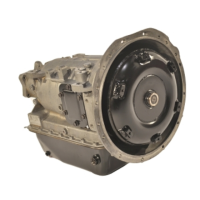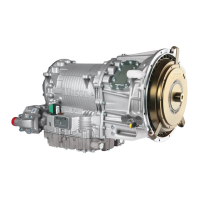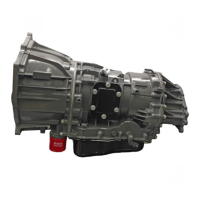2–6 Copyright © 1996 General Motors Corp.
AT 500, 1500 SERIES AUTOMATIC TRANSMISSIONS
2–15. OIL PAN AND FILTER
a. Description
(Foldout 12,B)
(1) Oil pan 26 or 33 is a pressed steel assem-
bly providing openings for draining the transmission
fluid and for mounting a fill tube and dipstick.
(2) Filter assembly 21, 38, or 46 is either a
paper element retained by a steel casing or a brass
screen assembly. The filter tube is not integral to the
filter.
(3) Transmission fluid from the sump is
drawn through the filter by the input oil pump and di-
rected to the hydraulic system. A washer-head screw
attaches the filter to the valve body.
(4) Deep pan units also use spacer 41 or 49
and a longer intake tube 40 or 48 between the filter and
the valve body.
b. Function
(Foldout 12,B)
(1) Oil pan 26 or 33 serves as the transmis-
sion fluid sump and covers the main control valve
body assembly and the filter. The oil pan must be re-
moved from the bottom of the transmission to replace
the filter.
(2) The filter assembly screens all transmis-
sion fluid entering the hydraulic system. The fluid
change interval is influenced by whether the transmis-
sion is fitted with a paper or with a brass filter. Refer to
Paragraph 3–8.
(3) In some models, a magnet in the oil pan
helps to accumulate any metal particles in the fluid
supply.
2–16. HYDRAULIC RETARDER
a. Description
(1) AT 542/545R models have a retarder lo-
cated on the input side of the transmission that is de-
signed for auxiliary braking for downhill speed con-
trol. This 160 hp retarder has a two-stage capacity
that, in conjunction with selection of the appropriate
ranges, can be used to tailor desired retardation perfor-
mance to particular duty cycles.
(2) A cross-section of the AT 542/545R is
shown on Foldout 3. The main retarder components
internal to the transmission are front stator 1 (Foldout
8), the rotor which is a part of forward clutch housing
14, and rear stator 35.
(3) The AT retarder has a dual torus design.
The retarder rotor provides high flow and torque gen-
eration. Front stator 1 and rear stator 35 are both sta-
tionary.
(4) The rotating element (rotor) of the re-
tarder is cast on the OD of forward clutch housing 13.
The rotor blades occupy approximately the same area
that the optional PTO gear occupies on a PTO-
equipped AT transmission. The valve body for the re-
tarder mounts to the transmission PTO pad. Transmis-
sion fluid is transferred to and from the retarder
through tubes that connect the externally-mounted re-
tarder controls to retarder housing 37.
b. Operation
(1) The hydraulic system introduces trans-
mission fluid through the tips of the rear stator blades
in rear housing assembly 35 (Foldout 8), which is an
extremely low pressure area. The fluid exits the torus
through a slot at the OD of the blades.
(2) The retarder fluid is transferred from the
retarder housing to the controls through two tubes. The
controls turn on the retarder, as well as perform capac-
ity regulation and cooler oil routing.
(3) The retarder is electronically activated by
solenoids (Foldout 4,A, B, and C). Main-pressure
from Solenoid
H
activates the autoflow valve. This
valve routes transmission cooler flow and fills the re-
tarder cavity through a regulator valve and priority
valve system.
(4) The routing of the fluid to the cooling
system is accomplished with the autoflow valve. When
closed, the transmission fluid is routed through both
primary and secondary coolers and the filter system.
When in retarder mode, the auto-flow valve opens and
directs converter-out transmission fluid through the
secondary cooler and filter system. Retarder fluid
flows through the primary cooler only.

